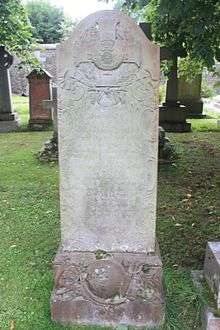William Francis Beattie
William Francis Beattie MC (1886-1918) was a promising Scottish sculptor killed in the closing weeks of the First World War. His most famous work is the 1514 in Hawick: a memorial to Hawick men killed in an aftermath battle following the Battle of Flodden, known as the Battle of Hornshole. The monument is known locally as “Ken the Horse”.[1]
Life

He was born in Hawick on 23 November 1886, the son of Annie Kate McMann and Thomas Beattie (1861-1933), a local sculptor, whose most notable work is the interior of the Usher Hall. It is likely that Thomas Beattie of Langholm (1860-1927) and also a sculptor, was probably a cousin. William’s grandfather had been a local pioneer of photography.[2]
William was educated at George Watson’s College and then the Edinburgh School of Art. Around 1901 he began actively sculpting in Edinburgh, first working from a studio at 109 Haymarket Terrace, then in 1912 moving to the more prestigious Dean Studios on Belford Road.[3] Whilst his work clearly is of great quality only one public work is known, it is therefore presumed that he specialised in figurative work as largely private commissions.
In 1910 he joined the Territorial branch of the Lothian and Border Horse Regiment. As a territorial, he was immediately called into service at the onset of the First World War. He transferred as a Lieutenant to the Royal Field Artillery and won the Military Cross from bravery in November 1917 for the rescue of two men from the battlefield during the Second Battle of Passchendaele.[4] He was thereafter promoted to the rank of Major. He fought at the Battle of Loos, Ypres and the Somme and had at least suffered due to a one gas attack (in April 1918).
He died of wounds at a field hospital near Joncourt on 3 October 1918, a few weeks before the end of the war, during the Hundred Days Offensive. The wounds were probably received during a skirmish a few days earlier. He is buried in Tincourt New British Cemetery near Peronne, Somme (grave ref V J 27).[5] His parents are noted as living at 41 Lothian Road in Edinburgh at the time of his death.
He is memorialised on his parents grave in the north section of Dean Cemetery in western Edinburgh.
Known Works
- The 1514 Monument, Hawick[6] This memorial was created in plaster in 1913 as a commission by Hawick Town Council to celebrate the quarcentenary in 1914 of the Battle of Hornshole in 1514. Although scheduled to be unveiled in 1914 the work was not completed at that point (a plaster version may have been unveiled on the scheduled date of 4 June 1914, as this was common practice). The whole commission as a bronze statue was put on hold due to the war. Due to the death of William the works were completed by his father Thomas Beattie, including overseeing of the casting, and eventually completed in 1923.[7]
References
- ↑ http://www.hawickcommonriding.com/1514.html
- ↑ http://www.hawickcommonriding.com/beattie.html
- ↑ http://sculpture.gla.ac.uk/view/person.php?id=msib6_1203332983
- ↑ The London Gazette, 26 November 1917
- ↑ http://www.cwgc.org/find-war-dead.aspx?cpage=1
- ↑ http://sculpture.gla.ac.uk/view/person.php?id=msib6_1203332983
- ↑ http://www.hawickcallantsclub.co.uk/cr11-bussing.shtml